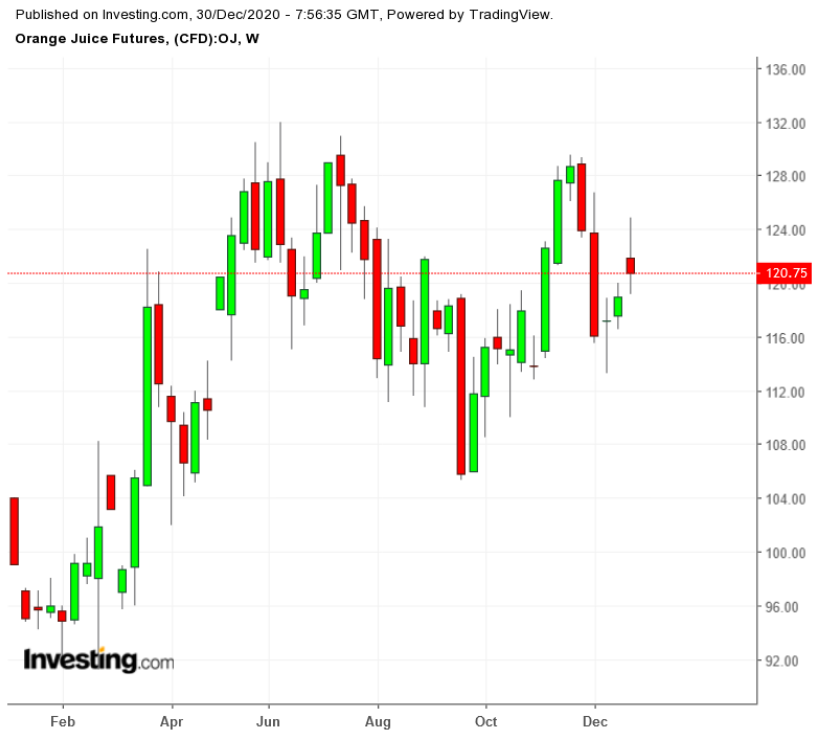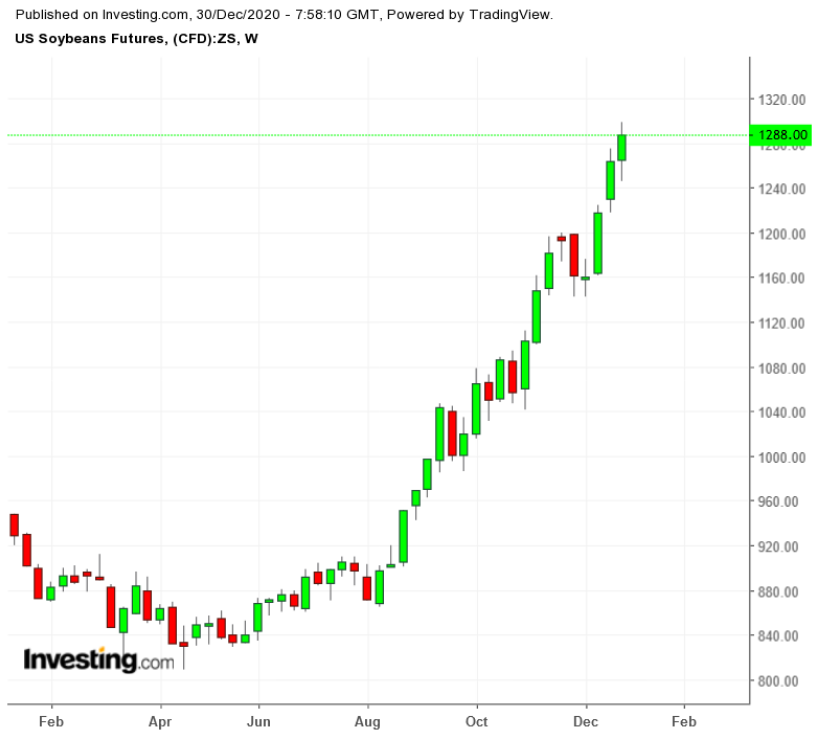The year of the pandemic continues to surprise, with 2020's choice of commodity winners and losers.
In the agricultural corner, despite the storm over U.S. tariffs on China and blow to animal feed demand at the height of the COVID-19 pandemic, the biggest gainer remains soybeans, edging out main contenders {8918|corn}} and wheat.

Even more remarkable, on the side of the so-called softs, it’s orange juice that gets the top prize for returns, beating out coffee, cocoa and sugar, which make up the rest of the complex.
Soybean futures on the Chicago Board of Trade, or CBOT, are up 37% on the year, trading at nearly $12.95 a bushel versus $9.44 at this time in December 2019.
But the farm price of soybeans is at around $9.63, giving the futures a premium of 35%.
The agricultural supply-demand estimate, released by the U.S. Department of Agriculture, or USDA, on Dec. 22 forecasts an average soybean farm price of $10.55 in 2021.
Seven-Year High For Soy Prices In 2021?

If the same farm-to-futures premium is applied to that, then CBOT soy prices could theoretically reach $14.25 next year. That would put them at seven-year highs, as the last time the market traded above $14 per bushel was during the spring of 2014.
On the back of strong export demand, lower ending stocks and higher prices, the USDA projects soybean acreage will increase by nearly 6 million acres, or 7%, from 2020 to 89 million acres planted. If realized, 2021 soybean acreage would be the third-highest acreage on record, behind only 2017 and 2018.
Chad Hart, an Iowa State University economist specializing in agriculture, said the market was predicting as many as 92 million planted acres for soybeans in 2021 — underscoring the strong export demand expected for the grain in the coming year.
In a Dec. 11 interview with the AgWeb portal, Hart said “all signals point to exports continuing to grow” in soybeans, although a 92-million-planted-acreage was unprecedented in U.S. history.
Hart said market opportunity and weather conditions will likely dictate total planted acres, adding that he was more in the “90- to 91-million-acre camp.”
But Hart said was firmly in agreement with the forecast $10 average farm price for 2021. He adds:
“It's a signal to bring (planted) area in, and it's based upon this really strong demand out there. We don't see the feed (demand) side backing off; we don't see exports backing off. And so, if anything, that's putting in a floor right now that could go even higher as we move forward.”
U.S. Soybean Exports: Heavy On China
Much of that export growth for the coming year will be headed to the same destination responsible for the chunk of U.S. soybean buying: China.
Being the country with the fastest and most visible rebound from COVID-19 so far, China has already bought more than 19 million tonnes of U.S. soybeans for crop year 2020-21, more than 10 times year ago-levels and the largest on record.
Despite such purchases, China’s demand for soy might be far beyond what American exporters could meet, said Bill Lapp, president at Advanced Economic Solutions, Omaha, Nebraska.
In an interview with told Milling & Baking News, he said:
“China is significantly short of the stated agricultural import goals of phase one, and despite a recent increase in US ag sales to China, it is unlikely China will reach the goals.”
“U.S. sales are largely for shipment during the September-January period. After that, Brazil is likely to be the primary supplier to China.”
Mr. Lapp pointed out China agreed to import roughly $33 billion in US agricultural products in 2020, and through July, China had imported $7.6 billion worth, or 23% of the annual goal.
He said China was also significantly short of overall goals of its so-called Phase One trade deal with the Trump administration, where it has purchased just $48 billion of U.S. products and services through July, versus its annual commitment for $143 billion.
With incoming Democrat President Joe Biden likely to roll back most, if not all, of his Republican predecessor Trump’s tariffs, China might actually buy more agriculture from the United States on willing terms than the coercion deployed by the outgoing administration.
Soybeans futures on the CBOT rallied their hardest this year in November and December — rising an even 11% for each of the two months — after it became clear that Biden had beaten Trump in the Nov. 3 presidential election.
Prior to that, soybeans had been on a rally too, though not by that much. After a fumbled start and weakness mostly through May, soybean prices have picked up and rallied without stop since June, averaging a growth of 4.7% a month in the five months to November.
Forecaster: Orange Juice Prices Could Hit 3-Year Highs In 2021
On the softs end, frozen concentrated orange juice, or FCOJ, on ICE (NYSE:ICE) Futures U.S. are poised to end 2020 up nearly 28%, trading near $1.25 per pound.
Gov.Capital, a service that forecasts commodity and other asset prices, sees FCOJ ranging mostly between $1.40 and $1.60 next year. The last time juice got to as high as $1.60 per lb was in 2018, raising the possibility that it could hit three-year highs in 2021.
One of the few commodities that directly prospered this year as a result of the coronavirus, OJ is expected to have a bright year as well in 2021 as people continue to seek nutritional foods and drinks amid the health scare generated by the pandemic.
Mike Seery, technical analyst for commodities in Plainfield, Illinois, told Investing.com in a recent interview that FCOJ looked poised for a move higher, adding: “If you are a long-term investor, I see no reason not to be a buyer.”
Jack Scoville, analyst at the Price Futures Group brokerage in Chicago, also has a favorable outlook on orange juice. Says Seery:
“The coronavirus is still promoting consumption of OJ at home. Restaurant and food service demand has been much less as no one is dining out.”
Disclaimer: Barani Krishnan uses a range of views outside his own to bring diversity to his analysis of any market. He does not own or hold a position in the commodities or securities he writes about.
